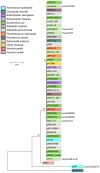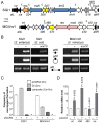The master activator of IncA/C conjugative plasmids stimulates genomic islands and multidrug resistance dissemination
- PMID: 25340549
- PMCID: PMC4207636
- DOI: 10.1371/journal.pgen.1004714
The master activator of IncA/C conjugative plasmids stimulates genomic islands and multidrug resistance dissemination
Abstract
Dissemination of antibiotic resistance genes occurs mostly by conjugation, which mediates DNA transfer between cells in direct contact. Conjugative plasmids of the IncA/C incompatibility group have become a substantial threat due to their broad host-range, the extended spectrum of antimicrobial resistance they confer, their prevalence in enteric bacteria and their very efficient spread by conjugation. However, their biology remains largely unexplored. Using the IncA/C conjugative plasmid pVCR94ΔX as a prototype, we have investigated the regulatory circuitry that governs IncA/C plasmids dissemination and found that the transcriptional activator complex AcaCD is essential for the expression of plasmid transfer genes. Using chromatin immunoprecipitation coupled with exonuclease digestion (ChIP-exo) and RNA sequencing (RNA-seq) approaches, we have identified the sequences recognized by AcaCD and characterized the AcaCD regulon. Data mining using the DNA motif recognized by AcaCD revealed potential AcaCD-binding sites upstream of genes involved in the intracellular mobility functions (recombination directionality factor and mobilization genes) in two widespread classes of genomic islands (GIs) phylogenetically unrelated to IncA/C plasmids. The first class, SGI1, confers and propagates multidrug resistance in Salmonella enterica and Proteus mirabilis, whereas MGIVmi1 in Vibrio mimicus belongs to a previously uncharacterized class of GIs. We have demonstrated that through expression of AcaCD, IncA/C plasmids specifically trigger the excision and mobilization of the GIs at high frequencies. This study provides new evidence of the considerable impact of IncA/C plasmids on bacterial genome plasticity through their own mobility and the mobilization of genomic islands.
Conflict of interest statement
The authors have declared that no competing interests exist.
Figures





Similar articles
-
Replication of the Salmonella Genomic Island 1 (SGI1) triggered by helper IncC conjugative plasmids promotes incompatibility and plasmid loss.PLoS Genet. 2020 Aug 6;16(8):e1008965. doi: 10.1371/journal.pgen.1008965. eCollection 2020 Aug. PLoS Genet. 2020. PMID: 32760058 Free PMC article.
-
Unraveling the regulatory network of IncA/C plasmid mobilization: When genomic islands hijack conjugative elements.Mob Genet Elements. 2015 May 21;5(3):1-5. doi: 10.1080/2159256X.2015.1045116. eCollection 2015 May-Jun. Mob Genet Elements. 2015. PMID: 26442183 Free PMC article.
-
The Salmonella genomic island 1 is specifically mobilized in trans by the IncA/C multidrug resistance plasmid family.PLoS One. 2010 Dec 20;5(12):e15302. doi: 10.1371/journal.pone.0015302. PLoS One. 2010. PMID: 21187963 Free PMC article.
-
The extended regulatory networks of SXT/R391 integrative and conjugative elements and IncA/C conjugative plasmids.Front Microbiol. 2015 Aug 20;6:837. doi: 10.3389/fmicb.2015.00837. eCollection 2015. Front Microbiol. 2015. PMID: 26347724 Free PMC article. Review.
-
Genomic islands related to Salmonella genomic island 1; integrative mobilisable elements in trmE mobilised in trans by A/C plasmids.Plasmid. 2021 Mar;114:102565. doi: 10.1016/j.plasmid.2021.102565. Epub 2021 Feb 11. Plasmid. 2021. PMID: 33582118 Review.
Cited by
-
Replication of the Salmonella Genomic Island 1 (SGI1) triggered by helper IncC conjugative plasmids promotes incompatibility and plasmid loss.PLoS Genet. 2020 Aug 6;16(8):e1008965. doi: 10.1371/journal.pgen.1008965. eCollection 2020 Aug. PLoS Genet. 2020. PMID: 32760058 Free PMC article.
-
A toxin antitoxin system promotes the maintenance of the IncA/C-mobilizable Salmonella Genomic Island 1.Sci Rep. 2016 Aug 31;6:32285. doi: 10.1038/srep32285. Sci Rep. 2016. PMID: 27576575 Free PMC article.
-
Crucial role of Salmonella genomic island 1 master activator in the parasitism of IncC plasmids.Nucleic Acids Res. 2021 Aug 20;49(14):7807-7824. doi: 10.1093/nar/gkab204. Nucleic Acids Res. 2021. PMID: 33834206 Free PMC article.
-
Characterization of Two Multidrug-Resistant IncA/C Plasmids from the 1960s by Using the MinION Sequencer Device.Antimicrob Agents Chemother. 2016 Oct 21;60(11):6780-6786. doi: 10.1128/AAC.01121-16. Print 2016 Nov. Antimicrob Agents Chemother. 2016. PMID: 27600047 Free PMC article.
-
Genomic islands targeting dusA in Vibrio species are distantly related to Salmonella Genomic Island 1 and mobilizable by IncC conjugative plasmids.PLoS Genet. 2021 Aug 20;17(8):e1009669. doi: 10.1371/journal.pgen.1009669. eCollection 2021 Aug. PLoS Genet. 2021. PMID: 34415925 Free PMC article.
References
-
- WHO (2014) Antimicrobial resistance: global report on surveillance. World Health Organization. pp. 257.
-
- Wantanabe T, Aoki T, Ogata Y, Egusa S (1971) Anbtibiotics and drug resistance in animals. R factors related to fish culturing. Ann N Y Acad Sci 182: 383–410. - PubMed
-
- Walsh TR, Weeks J, Livermore DM, Toleman MA (2011) Dissemination of NDM-1 positive bacteria in the New Delhi environment and its implications for human health: an environmental point prevalence study. Lancet Infect Dis 11: 355–362. - PubMed
Publication types
MeSH terms
LinkOut - more resources
Full Text Sources
Other Literature Sources

